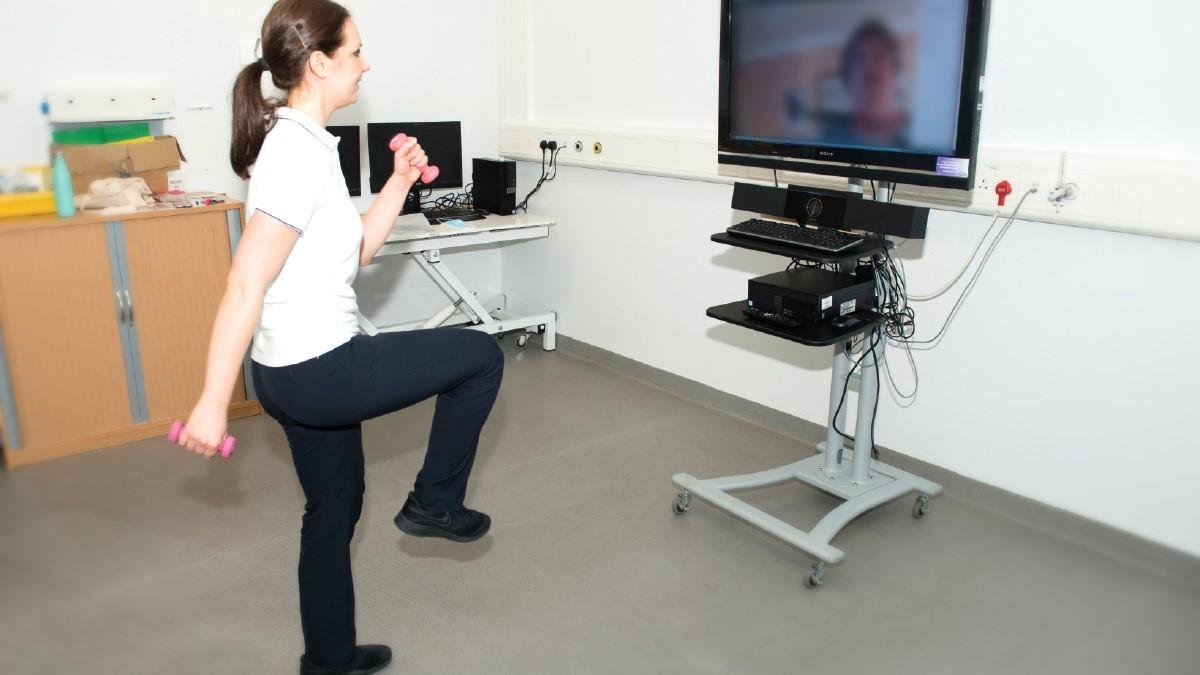Innovation and learning

Services have needed to change and adapt during the pandemic and there’s been much innovative practice and development of virtual practice like at University Hospitals Birmingham NHS Trust.
ICU follow-up services are now run virtually with online classes for Covid-recovery patients, delivered by physiotherapists.
Critical care rehab physio team lead Fiona Howroyd shares some practical tips to help other clinicians develop similar services:
‘Prior to the pandemic, we ran a weekly exercise class and support group for survivors of critical illness. The aim of the group was to help patients build their strength, fitness and confidence on discharge home, but also to offer support to patients knowing that critical illness can also impact patients emotionally and mentally.
‘Due to social distancing advice, we are unable to run this group face to face as normal, so we have since developed a virtual version.
‘Patients are able to log in live each week from their own homes to participate in a physiotherapy-led exercise class and afterwards take part in group discussion, led by ICU physiotherapists and follow-up nurses.
‘We are now running classes each week for the “general” ICU population and also groups specifically for Covid-19 ICU survivors.
‘During the development of this service we have learnt a lot regarding technology, risk assessment, appropriate outcome measures and adapting the class itself.’
Patient perspective
Mohammed: ‘It’s been invaluable to meet other Covid patients and staff that understand what we have been through.’
Michael: ‘The group has been really helpful – especially during the pandemic as it’s been quite isolating and I’ve been nervous to go out or use a gym.’
Proning lessons learned and ITU practice changed
At Queen Elizabeth Hospital Birmingham proning guidelines have been changed thanks to a team of therapists.
Senior physiotherapy team leader (MSK/upper limb) Jack Jeffrey explains: ‘During the Covid outbreak in spring our team were informed by our ICU and ward colleagues that patients were developing upper limb problems after being proned.
‘After setting up an inpatient referral pathway we identified problems such as shoulder dislocations, heterotopic ossification and neuropathies in the upper limb. Our early data has been published in Physical Therapy. Our team supported ward therapists with specialist upper limb care and advice. During this period we worked closely with our orthopaedic and nerve consultant colleagues.
‘We set up a therapy clinic to manage patient’s complex needs. Working with my OT colleague Emma Cahill we treat shoulder and hand disorders as well as global function and mobility issues. Some patients require surgery, that is nerve transfers, and so we also set them up for this. We work jointly with Fiona Howroyd identifying these patients in her post-ICU class.
‘Later in the year we also received referrals for frozen shoulders and stiff hands. Presently, we still receive referrals for patients with shoulder problems from the first wave. With this in mind we have worked with the MDT across ICU to change the proning guidelines within our trust and hope to see a reduction in injuries when we re-audit.
‘We already see changes to practice. It will be interesting to see to what impact our changes make as there is also the known direct effect that coronaviruses have on nerves and how Covid causes microvascular disturbances which may affect nerve blood supply.’
Reference
Caroline Miller, Joel O’Sullivan, Jack Jeffrey, Dominic Power, Brachial Plexus Neuropathies During the COVID-19 Pandemic: A Retrospective Case Series of 15 Patients in Critical Care, Physical Therapy, pzaa191
Jon Weblin, like Fiona, works in critical care at the Queen Elizabeth Hospital and in Covid ICU during the pandemic.
He normally works on a large general intensive care unit, as physiotherapy team lead for specialist (cancer) surgery.
‘During the pandemic in the Covid ICU I delivered respiratory care and early rehabilitation to patients.
‘To support the medical and nursing teams, I was also one of the physio team who took on increased responsibility to support management of ventilation, in accordance with lung protective ventilation guidelines.
This included calculation of targets for lung protective tidal volumes, which were then displayed in the patients’ bed space, alongside twice daily ventilation ward rounds, to ensure adherence or make the necessary adjustments to maintain these levels.’
Jon too has adapted to ‘virtual’ working for some of his cancer surgery clinics.
‘Our service has made our pre-assessment clinics and “surgery schools” virtual to ensure patients still receive the same high quality care.’
Number of subscribers: 1




































